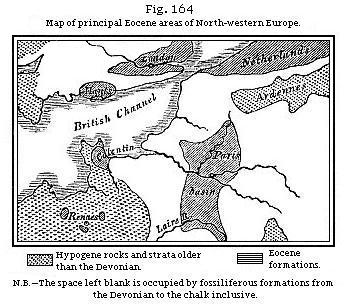
The Student’s Elements of Geology
Eocene Areas of North of Europe. — Table of English and French Eocene Strata. — Upper Eocene of England. — Bembridge Beds. — Osborne or St. Helen’s Beds. — Headon Series. — Fossils of the Barton Sands and Clays. — Middle Eocene of England. — Shells, Nummulites, Fish and Reptiles of the Bracklesham Beds and Bagshot Sands. — Plants of Alum Bay and Bournemouth. — Lower Eocene of England. — London Clay Fossils. — Woolwich and Reading Beds formerly called “Plastic Clay.” Fluviatile Beds underlying Deep-sea Strata. — Thanet Sands. — Upper Eocene Strata of France. — Gypseous Series of Montmartre and Extinct Quadrupeds. — Fossil Footprints in Paris Gypsum. — Imperfection of the Record. — Calcaire Silicieux. — Gres de Beauchamp. — Calcaire Grossier. — Miliolite Limestone. — Soissonnais Sands. — Lower Eocene of France. — Nummulitic Formations of Europe, Africa, and Asia. — Eocene Strata in the United States. — Gigantic Cetacean.
Eocene Areas of the North of Europe.—The strata next in order in the descending series are those which I term Eocene.

In the map (Fig. 164) the position of several Eocene areas in the north of Europe is pointed out. When this map was constructed I classed as the newer part of the
Eocene those Tertiary strata which have been described in the last chapter as Lower Miocene, and to which M. Beyrich has given the name of Oligocene. None of these occur in the London Basin, and they occupy in that of Hampshire, as we have seen at p. 244, too insignificant a superficial area to be noticed in a map on this scale. They fill a larger space in the Paris Basin between the Seine and the Loire, and constitute also part of the northern limits of the area of the Netherlands which are shaded in the map.
It is in the northern part of the Isle of Wight that we have the uppermost beds of the true Eocene best exhibited—namely, those which correspond in their fossils with the celebrated gypsum of the Paris basin before alluded to, p. 231 (see Table, p. 252). That gypsum has been selected by almost all Continental geologists as affording the best line of demarkation between the Middle and Lower Tertiary, or, in other words, between the Lower Miocene and Eocene formations.
In reference to the Table I may observe, that the correlation of the French and English subdivisions here laid down is often a matter of great doubt and difficulty, notwithstanding their geographical proximity. This arises from various circumstances, partly from the former prevalence of marine conditions in one basin simultaneously with fluviatile or lacustrine in the other, and sometimes from the existence of land in one area causing a break or absence of all records during a period when deposits may have been in progress in the other basin. As bearing on this subject, it may be stated that we have unquestionable evidence of oscillations of level shown by the superposition of salt or brackish-water strata to fluviatile beds; and those of deep-sea origin to strata formed in shallow water. Even if the upward and downward movements were uniform in amount and direction, which is very improbable, their effect in producing the conversion of sea into land or land into sea would be different, according to the previous shape and varying elevation of the land and bottom of the sea. Lastly, denudation, marine and subaërial, has frequently caused the absence of deposits in one basin of corresponding age to those in the other, and this destructive agency has been more than ordinarily effective on account of the loose and unconsolidated nature of the sands and clays.
| English subdivisions | French equivalents |
| A.1. Bembridge series, Isle of Wight, p. 252. | A.1. Gypseous series of Montmartre, p. 270. |
| A.2. Osborne or St. Helen's series, Isle of Wight, p. 255. | A.2 and 3. Calcaire siliceux, or Travertin Inférieur, p. 273. |
| A.3. Headon series, Isle of Wight, p. 255. | |
| A.4. Barton series. Sands and clays of Barton Cliff, Hants, p. 258. | A.4. Grès de Beauchamp, or Sables Moyens, p. 273. |
| MIDDLE EOCENE | |
| B.1. Bracklesham series, p. 259. | B.1. Calcaire Grossier p. 274 |
| B.2. Alum Bay and Bournemouth beds, p. 259. | B.2. Wanting in France? |
| B.2. Wanting in England? | B.2. Soissonnais Sands, or Lits Coquilliers, p. 275 |
| LOWER EOCENE | |
| C.1. London Clay, p. 263. | C.1. Argile de Londres, Cassel, near Dunkirk. |
| C.2. Woolwich and Reading series, p. 267. | C.2. Argile plastique and lignite, p. 276 |
| C.3. Thanet sands, p. 269. | C.3. Sables de Bracheux, p. 276 |
Bembridge Series, A.1.—These beds are about 120
feet thick, and, as stated in p.
245, lie immediately under the Hempstead beds, near Yarmouth,
in the Isle of Wight, being conformable with those Lower Miocene
strata. They consist of marls, clays, and limestones of
fresh-water, brackish, and marine origin. Some of the most abundant
shells, as Cyrena semistriata var., and Paludina
lenta, Fig. 163, are common to
this and to the overlying Hempstead series; but the majority of the
species are distinct. The following are the subdivisions described
by the late Professor Forbes:
a. Upper marls, distinguished
by the abundance of Melania turritissima, Forbes (Fig. 165).
b. Lower marls, characterised
by Cerithium mutabile, Cyrena pulchra, etc., and by the
remains of Trionyx (see Fig.
166).
c. Green marls, often
abounding in a peculiar species of oyster, and accompanied by
Cerithium, Mytilus, Arca, nucula, etc.
d. Bembridge limestones,
compact cream-coloured limestones alternating with shales and
marls, in all of which land-shells are common, especially at
Sconce, near Yarmouth,

as described by Mr. F. Edwards. The Bulimus ellipticus, Fig. 167, and Helix occlusa, Fig. 168, are among its best known land-shells. Paludina orbicularis, Fig. 169, is also of frequent occurrence. One of the bands is filled with a little globular Paludina. Among the fresh-water pulmonifera, Lymnea longiscata (Fig. 171) and Planorbis discus (Fig. 170)
are the most generally distributed: the latter represents or takes the place of the Planorbis euomphalus (see Fig. 175) of the more ancient Headon series. Chara tuberculata (Fig. 172) is the characteristic Bembridge gyrogonite or seed-vessel.

From this formation on the shores of Whitecliff Bay, Dr. Mantell obtained a fine specimen of a fan palm, Flabellaria Lamanonis, Brong., a plant first obtained from beds of corresponding age in the suburbs of Paris. The well-known building-stone of Binstead, near Ryde, a limestone with numerous hollows caused by Cyrenæ which have disappeared and left the moulds of their shells, belongs to this subdivision of the Bembridge series. In the same Binstead stone Mr. Pratt and the Reverend Darwin Fox first discovered the remains of mammalia characteristic of the gypseous series of Paris, as Palæotherium magnum (Fig. 174), P. medium, P. minus, P. minimum, P. curtum, P. crassum; also Anoplotherium commune (Fig. 173), A. secundarium, Dichobune cervinum, and Chæropotamus Cuvieri. The Palæothere above alluded to resembled the living tapir in the form of the head, and in having a short proboscis, but its molar teeth were more like those of the rhinoceros. Palæotherium magnum was of the size of a horse, three or four feet high. The woodcut, Fig. 174, is one of the restorations which Cuvier attempted of the outline of the living animal, derived from the study of the entire skeleton.

As the vertical range of particular species of quadrupeds, so far as our knowledge extends, is far more limited than that of the testacea, the occurrence of so many species at Binstead, agreeing with fossils of the Paris gypsum, strengthens the evidence derived from shells and plants of the synchronism of the two formations.
Osborne or St. Helen’s Series, A.2.—This group is of fresh and brackish-water origin, and very variable in mineral character and thickness. Near Ryde, it supplies a freestone much used for building, and called by Professor Forbes the Nettlestone grit. In one part ripple-marked flagstones occur, and rocks with fucoidal markings. The Osborne beds are distinguished by peculiar species of Paludina, Melania, and Melanopsis, as also of Cypris and the seeds of Chara.
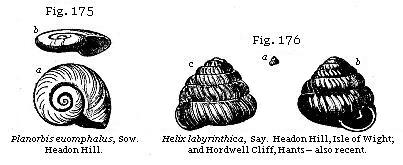
Headon Series A.3.—These beds are seen both in Whitecliff Bay, Headon Hill, and Alum Bay, or at the east and west extremities of the Isle of Wight. The upper and lower portions are fresh-water, and the middle of mixed origin, sometimes brackish and marine. Everywhere Planorbis euomphalus, Fig. 175, characterises the fresh-water deposits, just as the allied form, P. discus, Fig. 170, does the Bembridge limestone. The brackish-water beds contain Potamomya plana, Cerithium mutabile, and Potamides cinctus (Fig. 37), and the marine beds Venus (or Cytherea) incrassata, a species common to the Limburg beds and Grès de Fontainebleau, or the Lower Miocene series. The prevalence of salt-water remains is most conspicuous in some of the central parts of the formation.

Among the shells which are widely distributed through the Headon series are Neritina concava (Fig. 177), Lymnea caudata (Fig. 178), and Cerithium concavum (Fig. 179). Helix labyrinthica, Say (Fig. 176), a land-shell now inhabiting the United States, was discovered in this series by Mr. Searles Wood in Hordwell Cliff. It is also
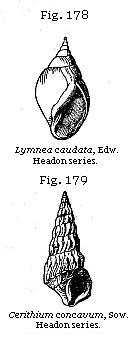
met with in Headon Hill, in the same beds. At Sconce, in the Isle of Wight, it occurs in the Bembridge series, and affords a rare example of an Eocene fossil of a species still living, though, as usual in such cases, having no local connection with the actual geographical range of the species. The lower and middle portion of the Headon series is also met with in Hordwell Cliff (or Hordle, as it is often spelt), near Lymington, Hants. Among the shells which abound in this cliff are Paludina lenta and various species of Lymnea, Planorbis, Melania, Cyclas, Unio, Potamomya, Dreissena, etc.
Among the chelonians we find a species of Emys, and no less than six species of Trionyx; among the saurians an alligator and a crocodile; among the ophidians two species of land-snakes (Paleryx, Owen); and among the fish Sir P. Egerton and Mr. Wood have found the jaws, teeth, and hard shining scales of the genus Lepidosteus, or bony pike of the American rivers. This same genus of fresh-water ganoids has also been met with in the Hempstead beds in the Isle of Wight. The bones of several birds have been obtained from Hordwell, and the remains of quadrupeds of the genera Palæotherium (P. minus), Anoplotherium, Anthracotherium, Dichodon, Dichobune, Spalacodon, and Hyænodon. The latter offers, I believe, the oldest known example of a true carnivorous animal in the series of British fossils, although I attach very little theoretical importance to the fact, because herbivorous species are those most easily met with in a fossil state in all save cavern deposits. In another point of view, however, this fauna deserves notice. Its geological position is considerably lower than that of the Bembridge or Montmartre beds, from which it differs almost as much in species as it does from the still more ancient fauna of the Lower Eocene beds to be mentioned in the sequel. It therefore teaches us what a grand succession of distinct assemblages of mammalia flourished on the earth during the Eocene period.
Many of the marine shells of the brackish-water beds of the above series, both in the Isle of Wight and Hordwell Cliff, are common to the underlying Barton Clay: and, on the other hand, there are some fresh-water shells, such as Cyrena obovata, which are common to the Bembridge beds, not-
withstanding the intervention of the St. Helen’s series. The white and green marls of the Headon series, and some of the accompanying limestones, often resemble the Eocene strata of France in mineral character and colour in so striking a manner as to suggest the idea that the sediment was derived from the same region or produced contemporaneously under very similar geographical circumstances.
At Brockenhurst, near Lyndhurst, in the New Forest, marine strata have recently been found containing fifty-nine shells, of which many have been described by Mr. Edwards. These beds rest on the Lower Headon, and are considered as the equivalent of the middle part of the Headon series, many of the shells being common to the brackish-water or Middle Headon beds of Colwell and Whitecliff Bays, such as Cancellaria muricata, Sowerby, Fusus labiatus, Sowerby, etc. In these beds at Brockenhurst, corals, ably described by Dr. Duncan, have recently been found in abundance and perfection; see Fig. 180, Solenastræa cellulosa.
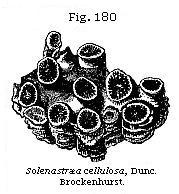
Baron von Könen* has pointed out that no less than forty-six out of the fifty-nine Brockenhurst shells, or a proportion of 78 per cent, agree with species occurring in Dumont’s Lower Tongrian formation in Belgium. This being the case, we might fairly expect that if we had a marine equivalent of the Bembridge series or of the contemporaneous Paris gypsum, we should find it to contain a still greater number of shells common to the Tongrian beds of Belgium, but the exact correlation of these fresh-water groups of France, Belgium, and Britain has not yet been fully made out. It is possible that the Tongrian of Dumont may be newer than the Bembridge series, and therefore referable to the Lower Miocene. If ever the whole series should be complete, we must be prepared to find the marine equivalent of the Bembridge beds, or the uppermost Eocene, passing by imperceptible shades into the inferior beds of the overlying Miocene strata.
Among the fossils found in the Middle Headon are Cytherea incrassata and Cerithium plicatum (Fig. 160). These shells, especially the latter, are very characteristic of the Lower Miocene, and their occurrence in the Headon series has been cited as an objection to the line proposed to be
* Quart. Geol. Journal, vol. xx, p. 97, 1864.
drawn between Miocene and Eocene. But if we were to attach importance to such occasional passages, we should soon find that no lines of division could be drawn anywhere, for in the present state of our knowledge of the Tertiary series there will always be species common to beds above and below our boundary-lines.

Barton Series (Sands and Clays), A.4 Table—Both in the Isle of Wight, and in Hordwell Cliff, Hants, the Headon beds, above-mentioned, rest on white sands usually devoid of fossils, and used in the Isle of Wight for making glass. In one of these sands Dr. Wright found Chama squamosa, a Barton Clay shell, in great plenty, and certain impressions of marine shells have been found in sands supposed to be of the same age in Whitecliff Bay. These sands have been called Upper Bagshot in the maps of our Government Survey, but this identification of a fossiliferous series in the Isle of Wight with an unfossiliferous formation in the London Basin can scarcely be depended upon. The Barton Clay, which immediately underlies these sands, is seen vertical in Alum Bay, Isle of Wight, and nearly horizontal in the cliffs of the mainland near Lymington. This clay, together with the Bracklesham beds, presently to be described, has been termed Middle Bagshot by the Survey. In Barton Cliff, where it attains a thickness of about 300 feet, it is rich in marine fossils.
It was formerly confounded with the London Clay, an older Eocene deposit of very similar mineral character, to be mentioned (p. 263), which contains many shells in common, but not more than one-fourth of the whole. In other words, there are known at present 247 species in the London Clay and 321 in that of Barton, and only 70 common to the two formations. Fifty-six of these have been found in the intermediate Bracklesham beds, and the reappearance of the other 14 may imply a return of similar conditions, whether of temperature or depth or of a muddy argillaceous bottom, common to the two periods of the London and Barton Clays. According to M. Hebert, the most characteristic Barton Clay fossils correspond to those of the Gres de Beauchamp, or Sables Moyens, of the Paris Basin, but it also contains many common to the older Calcaire Grossier.
Certain foraminifera called Nummulites begin, when we study the Tertiary formations in a descending order, to make
their first appearance in these beds. A small species called Nummulites variolaria, Fig. 190, is found both on the Hampshire coast and in beds of the same age in Whitecliff Bay, in the Isle of Wight. Several marine shells, such as Corbula pisum (Fig. 158), are common to the Barton beds and the Hempstead or Lower Miocene series, and a still greater number, as before stated, are common to the Headon series.
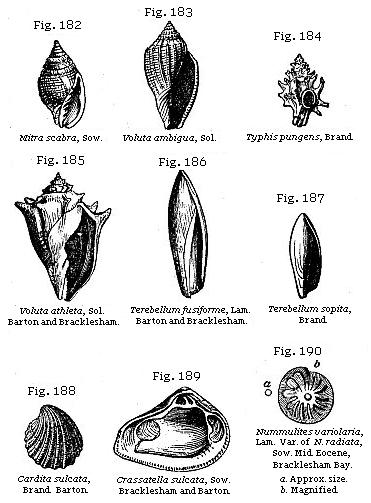
Bracklesham Beds and Bagshot Sands, B.1, Table—Beneath the Barton Clay we find in the north of the Isle of Wight, both in Alum and Whitecliff Bays, a great series of various coloured sands and clays for the most part unfossiliferous,
and probably of estuarine origin. As some of these beds contain Cardita planicosta (Fig. 191) they have been identified with the marine beds much richer in fossils seen in the coast section in Bracklesham Bay near Chichester in Sussex, where the strata consist chiefly of green clayey sands with some lignite. Among the Bracklesham fossils besides the Cardita, the huge Cerithium giganteum is seen, so conspicuous in the Calcaire Grossier of Paris, where it is sometimes two feet in length. The Nummulites lævigata (see Fig. 192), so characteristic of the lower beds of the Calcaire Grossier in France, where it sometimes forms stony layers, as near Compiègne, is very common in these beds, together with N. scabra and N. variolaria. Out of 193 species of testacea procured from the Bagshot and Bracklesham beds in England, 126 occur in the Calcaire Grossier in France. It was clearly, therefore, coeval with that part of the Parisian series more nearly than with any other.
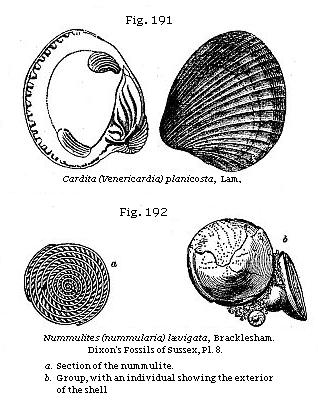
According to tables compiled from the best authorities by Mr. Etheridge, the number of mollusca now known from the Bracklesham beds in Great Britain is 393, of which no less
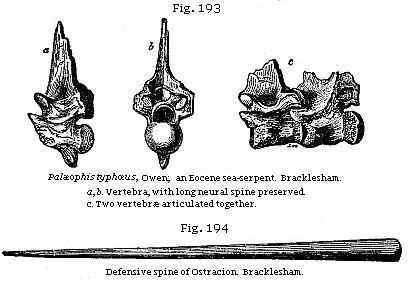
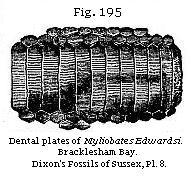
than 240 are peculiar to this subdivision of the British Eocene series, while 70 are common to the Older London Clay, and 140 to the Newer Barton Clay. The volutes and cowries of this formation, as well as the lunulites and corals, favour the idea of a warm climate having prevailed, which is borne out by the discovery of a serpent, Palæophis typhœus (see Fig. 193), exceeding, according to Professor Owen, twenty feet in length, and allied in its osteology to the Boa, Python, Coluber, and Hydrus. The compressed form and diminutive size of certain caudal vertebræ indicate so much analogy with Hydrus as to induce Professor Owen to pronounce this extinct ophidian to have been marine.* Among the companions of the sea-snake of Bracklesham was an extinct crocodile (Gavialis Dixoni, Owen), and numerous fish, such as now frequent the seas of warm latitudes, as the Ostracion of the family Balistidæ, of which a dorsal spine is figured (see Fig. 194), and gigantic rays of the genus Myliobates (see Fig. 195).
The teeth of sharks also, of the genera Carcharodon, Otodus, Lamna, Galeocerdo, and others, are abundant. (See Figs. 196, 197, 198, 199.)
* Palæont. Soc. Monograph, Rept., pt. ii, p. 61.

Alum Bay and Bournemouth Beds. (Lower Bagshot of English Survey), B.2, Table—To that great series of sands and clays which intervene between the equivalents of the Bracklesham Beds and the London Clay or Lower Eocene, our Government Survey has given the name of the Lower Bagshot sands, for they are supposed to agree in age with the inferior unfossiliferous sands of the country round Bagshot in the London Basin. This part of the series is finely exposed in the vertical beds of Alum bay, in the Isle of Wight, and east and west of Bournemouth, on the south coast of Hampshire. In some of the close and white compact clays of this locality, there are not only dicotyledonous leaves, but numerous fronds of ferns allied to Gleichenia which are well preserved with their fruit.
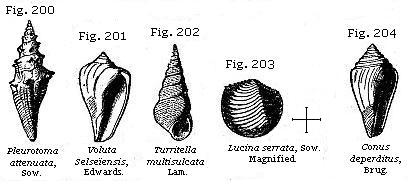
black carbonaceous seams and lignite. In the midst of these leaf-beds in Studland Bay, Purbeck shells of the genus Unio attest the fresh-water origin of the white clay.
No less than forty species of plants are mentioned by MM. de la Harpe and Gaudin from this formation in Hampshire, among which the Proteaceæ (Dryandra, etc.) and the fig tribe are abundant, as well as the cinnamon and several other laurineæ, with some papilionaceous plants. On the whole, they remind the botanist of the types of subtropical India and Australia.*
Heer has mentioned several species which are common to this Alum Bay flora and that of Monte Bolca, near Verona, so celebrated for its fossil fish, and where the strata contain nummulites and other Middle Eocene fossils. He has particularly alluded to Aralia primigenia (of which genus a fruit has since been found by Mr. Mitchell at Bournemouth), Daphnogene Veronensis, and Ficus granadilla, as among the species common to and characteristic of the Isle of Wight and Italian Eocene beds; and he observes that in the flora of this period these forms of a temperate climate which constitute a marked feature in the European Miocene formations, such as the willow, poplar, birch, alder, elm, hornbeam, oak, fir, and pine, are wanting. The American types are also absent, or much more feebly represented than in the Miocene period, although fine specimens of the fan-palm (Sabal) have been found in these Eocene clays at Studland. The number of exotic forms which are common to the Eocene and Miocene strata of Europe, like those to be alluded to in the sequel which are common to the Eocene and Cretaceous fauna, demonstrate the remoteness of the times in which the geographical distribution of living plants originated. A great majority of the Eocene genera have disappeared from our temperate climates, but not the whole of them; and they must all have exerted some influence on the assemblages of species which succeeded them. Many of these last occurring in the Upper Miocene are indeed so closely allied to the flora now surviving as to make it questionable, even in the opinion of naturalists opposed to the doctrine of transmutation, whether they are not genealogically related the one to the other.
London Clay, C.1, Table—This formation underlies the preceding, and sometimes attains a thickness of 500 feet. It consists of tenacious brown and bluish-grey clay,
* Heer, Climat et Végétation du Pays Tertiaire, p. 172.
with layers of concretions called septaria, which abound chiefly in the brown clay, and are obtained in sufficient numbers from sea-cliffs near Harwich, and from shoals off the coast of Essex and the Isle of Sheppey, to be used for making Roman cement. The total number of British fossil mollusca known at present (January, 1870) in this formation are 254, of which 166 are peculiar, or not found in other Eocene beds in this country. The principal localities of fossils in the London clay are Highgate Hill, near London, the Island of Sheppey at the mouth of the Thames, and Bognor on the Sussex coast. Out of 133 fossil shells, Mr. Prestwich found only 20 to be common to the Calcaire Grossier (from which 600 species have been obtained), while 33 are common to the “Lits Coquilliers” (p. 275), in which 200 species are known in France.
In the Island of Sheppey near the mouth of the Thames, the thickness of the London Clay is estimated by Mr. Prestwich to be more than 500 feet, and it is in the uppermost 50 feet that a great number of fossil fruits were obtained, being chiefly found on the beach when the sea has washed away the clay of the rapidly wasting cliffs.
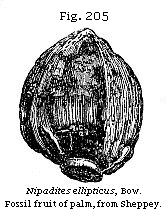
Mr. Bowerbank, in a valuable publication on these fossil fruits and seeds, has described no less than thirteen fruits of palms of the recent type Nipa, now only found in the Molucca and Philippine Islands, and in Bengal (see Fig. 205). In the delta of the Ganges, Dr. Hooker observed the large nuts of Nipa fruticans floating in such numbers in the various arms of that great river, as to obstruct the paddle-wheels of steamboats. These plants are allied to the cocoanut tribe on the one side, and on the other to the Pandanus, or screw-pine. There are also met with three species of Anona, or custard-apple; and cucurbitaceous fruits (of the gourd and melon family), and fruits of various species of Acacia.
Besides fir-cones or fruit of true Coniferæ there are cones of Proteaceæ in abundance, and the celebrated botanist the late Robert Brown pointed out the affinity of these to the New Holland types Petrophila and Isopogon. Of the first there are about fifty, and of the second thirty described species now living in Australia.
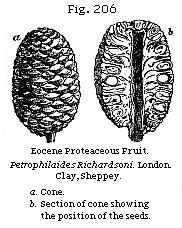
Ettingshausen remarked in 1851 that five of the fossil species from Sheppey, named by Bowerbank* were specimens of the same fruit (see Fig. 206), in different states of preservation; and Mr. Carruthers, having examined the original specimens now in the British Museum, tells me that all these cones from Sheppey may be reduced to two species, which have an undoubted affinity to the two existing Australian genera above mentioned, although their perfect identity in structure can not be made out.
The contiguity of land may be inferred not only from these vegetable productions, but also from the teeth and bones of crocodiles and turtles, since these creatures, as Dean Conybeare remarked, must have resorted to some shore to lay their eggs. Of turtles there were numerous species referred to extinct genera. These are, for the most part, not equal in size to the largest living tropical turtles. A sea-snake, which must have been thirteen feet long, of the genus Palæophis before mentioned (p. 261) has also been described by Professor Owen from Sheppey, of a different species from that of Bracklesham, and called P. toliapicus. A true crocodile, also, Crocodilus toliapicus, and another saurian more nearly allied to the gavial, accompany the above fossils; also the relics of several birds and quadrupeds. One of these last belongs to the new genus Hyracotherium of Owen, of the hog tribe, allied to Chæropotamus, another is a Lophiodon; a third a pachyderm called Coryphodon eocænus by Owen, larger than any existing tapir. All these animals seem to have inhabited the banks of the great river which floated down the Sheppey fruits. They imply the existence of a mammiferous fauna antecedent to the period when nummulites flourished in Europe and Asia, and therefore before the Alps, Pyrenees, and other mountain-chains now forming the backbones of great continents, were raised from the deep; nay, even before a part of the constituent rocky masses now entering into the central ridges of these chains had been deposited in the sea.
The marine shells of the London Clay confirm the inference derivable from the plants and reptiles in favour of a high temperature. Thus many species of Conus and Voluta
* Bowerbank, Fossil Fruits and Seeds of London Clay, Plates ix and x.
occur, a large Cypræa, C. oviformis, a very large Rostellaria (Fig. 209), a species of Cancellaria, six species of Nautilus (Fig. 211), besides other Cephalopoda of extinct genera, one of the most remarkable of which is the Belosepia (Fig. 212).

Among many characteristic bivalve shells are Leda amygdaloides (Fig. 213) and Cryptodon angulatum (Fig. 214), and among the Radiata a star-fish, Astropecten (Fig. 215.)
These fossils are accompanied by a sword-fish (Tetrapterus priscus, Agassiz), about eight feet long, and a saw-fish (Pristis bisulcatus, Agassiz), about ten feet in length; genera now foreign to the British seas. On the whole, about eighty species of fish have been described by M. Agassiz from these beds of Sheppey, and they indicate, in his opinion, a warm climate.
In the lower part of the London clay at Kyson, a few miles east of Woodbridge, the remains of mammalia have been detected. Some of these have been referred by Professor Owen to an opossum, and others to the genus Hyracotherium. The teeth of this last-mentioned pachyderm were at first, in 1840, supposed to belong to a monkey, an opinion afterwards abandoned by Owen when more ample materials for comparison were obtained.
Woolwich and Reading Series, C.2, Table—This formation was formerly called the Plastic Clay, as it agrees with a similar clay used in pottery which occupies the same position in the French series, and it has been used for the like purposes in England.*
No formations can be more dissimilar, on the whole, in mineral character than the Eocene deposits of England and Paris; those of our own island being almost exclusively of mechanical origin—accumulations of mud, sand, and pebbles; while in the neighbourhood of Paris we find a great succession of strata composed of limestones, some of them siliceous, and of crystalline gypsum and siliceous sandstone, and sometimes of pure flint used for millstones. Hence it is often impossible, as before stated, to institute an exact comparison between the various members of the English and French series, and to settle their respective ages. But in regard to the division which we have now under consideration, whether we study it in the basins of London, Hampshire, or Paris, we recognise as a general rule the same mineral character, the beds consisting over a large area of mottled clays and sand, with lignite, and with some strata of well-rolled flint pebbles, derived from the chalk, varying in size, but occasionally several inches in diameter. These strata may be seen in the Isle of Wight in contact with the chalk, or in the London basin, at Reading, Blackheath, and Woolwich. In some of the lowest of them, banks of oysters are observed, consisting of Ostrea bellovacina, so common in France in the
* Prestwich, Quart. Geol. Journ., vol. x.
same relative position. In these beds at Bromley, Dr. Buckland found a large pebble to which five full-grown oysters were affixed, in such a manner as to show that they had commenced their first growth upon it, and remained attached to it through life.
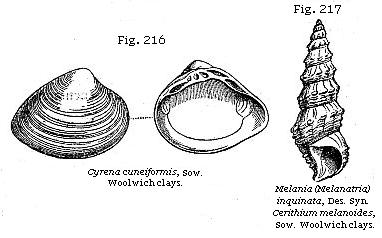
In several places, as at Woolwich on the Thames, at Newhaven in Sussex, and elsewhere, a mixture of marine and fresh-water testacea distinguishes this member of the series. Among the latter, Cyrena cuneiformis (see Fig. 216) and Melania inquinata (see Fig. 217) are very common, as in beds of corresponding age in France. They clearly indicate points where rivers entered the Eocene sea. Usually there is a mixture of brackish, fresh-water, and marine shells, and sometimes, as at Woolwich, proofs of the river and the sea having successively prevailed on the same spot. At New Charlton, in the suburbs of Woolwich, Mr. de la Condamine discovered in 1849, and pointed out to me, a layer of sand associated with well-rounded flint pebbles in which numerous individuals of the Cyrena tellinella were seen standing endwise with both their valves united, the siphonal extremity of each shell being uppermost, as would happen if the mollusks had died in their natural position. I have described a bank of sandy mud, in the delta of the Alabama River at Mobile, on the borders of the Gulf of Mexico, where in 1846 I dug out at low tide specimens of living species of Cyrena and of a Gnathodon, which were similarly placed with their shells erect, or in a posture which enables the animal to protrude its siphon upward, and draw in or reject water at pleasure. The water at Mobile is usually fresh,
* Second Visit to the United States, vol. ii, p. 104.
but sometimes brackish. At Woolwich a body of river-water must have flowed permanently into the sea where the Cyrenæ lived, and they may have been killed suddenly by an influx of pure salt-water, which invaded the spot when the river was low, or when a subsidence of land took place. Traced in one direction, or eastward towards Herne Bay, the Woolwich beds assume more and more of a marine character; while in an opposite, or south-western direction, they become, as near Chelsea and other places, more fresh-water, and contain Unio, Paludina, and layers of lignite, so that the land drained by the ancient river seems clearly to have been to the south-west of the present site of the metropolis.
Fluviatile Beds underlying Deep-sea Strata.—Before the minds of geologists had become familiar with the theory of the gradual sinking of land, and its conversion into sea at different periods, and the consequent change from shallow to deep water, the fluviatile and littoral character of this inferior group appeared strange and anomalous. After passing through hundreds of feet of London clay, proved by its fossils to have been deposited in deep salt-water, we arrive at beds of fluviatile origin, and associated with them masses of shingle, attaining at Blackheath, near London, a thickness of 50 feet. These shingle banks are probably of marine origin, but they indicate the proximity of land, and the existence of a shore where the flints of the chalk were rolled into sand and pebbles, and spread over a wide space. We have, therefore, first, as before stated (p. 268), evidence of oscillations of level during the accumulation of the Woolwich series, then of a great submergence, which allowed a marine deposit 500 thick to be laid over the antecedent beds of fresh and brackish water origin.
Thanet Sands, C.3, Table—The Woolwich or plastic clay above described may often be seen in the Hampshire basin in actual contact with the chalk, constituting in such places the lowest member of the British Eocene series. But at other points another formation of marine origin, characterised by a somewhat different assemblage of organic remains, has been shown by Mr. Prestwich to intervene between the chalk and the Woolwich series. For these beds he has proposed the name of “Thanet Sands,” because they are well seen in the Isle of Thanet, in the northern part of Kent, and on the sea-coast between Herne Bay and the Reculvers, where they consist of sands with a few concretionary masses of sandstone, and contain, among other fossils, Pholadomya cuneata, Cyprina morrisii, Corbula longirostris, Scalaria Bowerbankii, etc. The greatest thickness of these beds is 90 feet.
The tertiary formations in the neighbourhood of Paris consist of a series of marine and fresh-water strata, alternating with each other, and filling up a depression in the chalk. The area which they occupy has been called the Paris Basin, and is about 180 miles in its greatest length from north to south, and about 90 miles in breadth from east to west. MM. Cuvier and Brongniart attempted, in 1810, to distinguish five different groups, comprising three fresh-water and two marine, which were supposed to imply that the waters of the ocean, and of rivers and lakes, had been by turns admitted into and excluded from the same area. Investigations since made in the Hampshire and London basins have rather tended to confirm these views, at least so far as to show that since the commencement of the Eocene period there have been great movements of the bed of the sea, and of the adjoining lands, and that the superposition of deep-sea to shallow-water deposits (the London Clay, for example, to the Woolwich beds) can only be explained by referring to such movements. It appears, notwithstanding, from the researches of M. Constant Prevost, that some of the minor alternations and intermixtures of fresh-water and marine deposits, in the Paris basin, may be accounted for without such changes of level, by imagining both to have been simultaneously in progress, in the same bay of the same sea, or a gulf into which many rivers entered.
Gypseous Series of Montmartre, A.1, Table—To enlarge on the numerous subdivisions of the Parisian strata would lead me beyond my present limits; I shall therefore give some examples only of the most important formations. Beneath the Grès de Fontainebleau, belonging to the Lower Miocene period, as before stated, we find, in the neighbourhood of Paris, a series of white and green marls, with subordinate beds of gypsum. These are most largely developed in the central parts of the Paris basin, and, among other places, in the hill of Montmartre, where its fossils were first studied by Cuvier.
The gypsum quarried there for the manufacture of plaster of Paris occurs as a granular crystalline rock, and, together with the associated marls, contains land and fluviatile shells, together with the bones and skeletons of birds and quadrupeds. Several land-plants are also met with, among which are fine specimens of the fan-palm or palmetto tribe (Flabellaria). The remains also of fresh-water fish, and of crocodiles and other reptiles, occur in the gypsum. The skeletons of
mammalia are usually isolated, often entire, the most delicate extremities being preserved; as if the carcasses, clothed with their flesh and skin, had been floated down soon after death, and while they were still swollen by the gases generated by their first decomposition. The few accompanying shells are of those light kinds which frequently float on the surface of rivers, together with wood.
In this formation the relics of about fifty species of quadrupeds, including the genera Palæotherium (see Fig. 174), Anoplotherium (see Fig. 218), and others, have been found, all extinct, and nearly four-fifths of them belonging to the Perissodactyle or odd-toed division of the order Pachydermata, which now contains only four living genera, namely, rhinoceros, tapir, horse, and hyrax. With them a few carnivorous animals are associated, among which are the Hyænodon dasyuroides, a species of dog, Canis Parisiensis, and a weasel, Cynodon Parisiensis. Of the Rodentia are found a squirrel; of the Cheiroptera, a bat; while the Marsupalia (an order now confined to America, Australia, and some contiguous islands) are represented by an opossum.
Of birds, about ten species have been ascertained, the skeletons of some of which are entire. None of them are referable to existing species.* The same remark, according to MM. Cuvier and Agassiz, applies both to the reptiles and fish. Among the last are crocodiles and tortoises of the genera Emys and Trionyx.
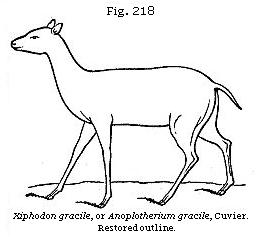
The tribe of land quadrupeds most abundant in this formation is such as now inhabits alluvial plains and marshes, and the banks of rivers and lakes, a class most exposed to suffer by river inundations. Among these were several species of Palæotherium, a genus before alluded to. These were associated with the Anoplotherium, a tribe intermediate between pachyderms and ruminants. One of the three divisions of this family was called by Cuvier Xiphodon. Their forms were slender and
* Cuvier, Oss. Foss., tome iii, p. 255.
elegant, and one, named Xiphodon gracile (Fig. 218), was about the size of the chamois; and Cuvier inferred from the skeleton that it was as light, graceful, and agile as the gazelle.
Fossil Footprints.—There are three superimposed masses of gypsum in the neighbourhood of Paris, separated by intervening deposits of laminated marl. In the uppermost of the three, in the valley of Montmorency, M. Desnoyers discovered in 1859 many footprints of animals occurring at no less than six different levels.* The gypsum to which they belong varies from thirty to fifty feet in thickness, and is that which has yielded to the naturalist the largest number of bones and skeletons of mammalia, birds, and reptiles. I visited the quarries, soon after the discovery was made known, with M. Desnoyers, who also showed me large slabs in the Museum at Paris, where, on the upper planes of stratification, the indented foot-marks were seen, while corresponding casts in relief appeared on the lower surfaces of the strata of gypsum which were immediately superimposed. A thin film of marl, which before it was dried and condensed by pressure must have represented a much thicker layer of soft mud, intervened between the beds of solid gypsum. On this mud the animals had trodden, and made impressions which had penetrated to the gypseous mass below, then evidently unconsolidated. Tracks of the Anoplotherium with its bisulcate hoof, and the trilobed footprints of Palæotherium, were seen of different sizes, corresponding to those of several species of these genera which Cuvier had reconstructed, while in the same beds were foot-marks of carnivorous mammalia. The tracks also of fluviatile, lacustrine, and terrestrial tortoises (Emys, Trionyx, etc.) were discovered, also those of crocodiles, iguanas, geckos, and great batrachians, and the footprints of a huge bird, apparently a wader, of the size of the gastornis, to be mentioned in the sequel. There were likewise the impressions of the feet of other creatures, some of them clearly distinguishable from any of the fifty extinct types of mammalia of which the bones have been found in the Paris gypsum. The whole assemblage, says Desnoyers, indicate the shores of a lake, or several small lakes communicating with each other, on the borders of which many species of pachyderms wandered, and beasts of prey which occasionally devoured them. The tooth-marks of these last had been detected by palæontologists long before on the bones and skulls of Paleotheres entombed in the gypsum.
* Sur des Empreintes de Pas d’Animaux par M. J. Desnoyers. Compte rendu de l’Institut, 1859.
Imperfection of the Record.—These foot-marks have revealed to us new and unexpected proofs that the air-breathing fauna of the Upper Eocene period in Europe far surpassed in the number and variety of its species the largest estimate which had previously been formed of it. We may now feel sure that the mammalia, reptiles, and birds which have left portions of their skeletons as memorials of their existence in the solid gypsum constituted but a part of the then living creation. Similar inferences may be drawn from the study of the whole succession of geological records. In each district the monuments of periods embracing thousands, and probably in some instances hundreds of thousands of years, are totally wanting. Even in the volumes which are extant the greater number of the pages are missing in any given region, and where they are found they contain but few and casual entries of the physical events or living beings of the times to which they relate. It may also be remarked that the subordinate formations met with in two neighbouring countries, such as France and England (the minor Tertiary groups above enumerated), commonly classed as equivalents and referred to corresponding periods, may nevertheless have been by no means strictly coincident in date. Though called contemporaneous, it is probable that they were often separated by intervals of many thousands of years. We may compare them to double stars, which appear single to the naked eye because seen from a vast distance in space, and which really belong to one and the same stellar system, though occupying places in space extremely remote if estimated by our ordinary standard of terrestrial measurements.
Calcaire silicieux, or Travertin inférieur, A.2 and 3, Table—This compact siliceous limestone extends over a wide area. It resembles a precipitate from the waters of mineral springs, and is often traversed by small empty sinuous cavities. It is, for the most part, devoid of organic remains, but in some places contains fresh-water and land species, and never any marine fossils. The calcaire siliceux and the calcaire grossier usually occupy distinct parts of the Paris basin, the one attaining its fullest development in those places where the other is of slight thickness. They are described by some writers as alternating with each other towards the centre of the basin, as at Sergy and Osny.
The gypsum, with its associated marls before described, is in greatest force towards the centre of the basin, where the calcaire grossier and calcaire silicieux are less fully developed.
Grès de Beauchamp, or Sables Moyens, A.4, Table—In some parts of the Paris basin, sands and marls, called the
Grès de Beauchamp, or Sables moyens, divide the gypseous beds from the calcaire grossier proper. These sands, in which a small nummulite (N. variolaria) is very abundant, contain more than 300 species of marine shells, many of them peculiar, but others common to the next division.
Calcaire Grossier, upper and middle, B.1, Table—The upper division of this group consists in great part of beds of compact, fragile limestone, with some intercalated green marls. The shells in some parts are a mixture of Cerithium, Cyclostoma, and Corbula; in others Limnea, Cerithium, Paludina, etc. In the latter, the bones of reptiles and mammalia, Palæotherium and Lophiodon, have been found. The middle division, or calcaire grossier proper, consists of a coarse limestone, often passing into sand. It contains the greater number of the fossil shells which characterise the Paris basin. No less than 400 distinct species have been procured from a single spot near Grignon, where they are imbedded in a calcareous sand, chiefly formed of comminuted shells, in which, nevertheless, individuals in a perfect state of preservation, both of marine, terrestrial, and fresh-water species, are mingled together. Some of the marine shells may have lived on the spot; but the Cyclostoma and Limnea, being land and fresh-water shells, must have been brought thither by rivers and currents, and the quantity of triturated shells implies considerable movement in the waters.
Nothing is more striking in this assemblage of fossil testacea than the great proportion of species referable to the genus Cerithium (see p. 245). There occur no less than 137 species of this genus in the Paris basin, and almost all of them in the calcaire grossier. Most of the living Cerithia inhabit the sea near the mouths of rivers, where the waters are brackish; so that their abundance in the marine strata now under consideration is in harmony with the hypothesis that the Paris basin formed a gulf into which several rivers flowed.
In some parts of the calcaire grossier round Paris, certain beds occur of a stone used in building, and called by the French geologists “Miliolite limestone.” It is almost entirely made up of millions of microscopic shells, of the size of minute grains of sand, which all belong to the class Foraminifera. Examples of some of these are given in Figs. 219 to 221. As this miliolitic stone never occurs in the Faluns, or Upper Miocene strata of Brittany and Touraine, it often furnishes the geologist with a useful criterion for
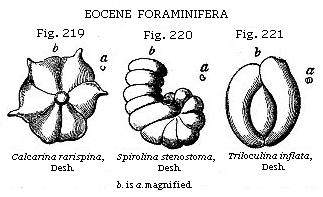
distinguishing the detached Eocene and Upper Miocene formations scattered over those and other adjoining provinces. The discovery of the remains of Palæotherium and other mammalia in some of the upper beds of the calcaire grossier shows that these land animals began to exist before the deposition of the overlying gypseous series had commenced.
Lower Calcaire grossier, or Glauconie grossiere, B.1, Table—The lower part of the calcaire grossier, which often contains much green earth, is characterised at Auvers, near Pontoise, to the north of Paris, and still more in the environs of Compiègne, by the abundance of nummulites, consisting chiefly of N. lævigata, N. scabra, and N. Lamarcki, which constitute a large proportion of some of the stony strata, though these same foraminifera are wanting in beds of similar age in the immediate environs of Paris.
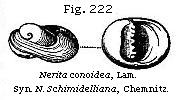
Soissonnais sands, or Lits coquilliers, B.2, Table—Below the preceding formation, shelly sands are seen, of considerable thickness, especially at Cuisse-Lamotte, near Compiègne, and other localities in the Soissonnais, about fifty miles N.E. of Paris, from which about 300 species of shells have been obtained, many of them common to the calcaire grossier and the Bracklesham beds of England, and many peculiar. The Nummulites planulata is very abundant, and the most characteristic shell is the Nerita conoidea, Lam., a fossil which has a very wide geographical range; for, as M. d’Archiac remarks, it accompanies the nummulitic formation from Europe to India, having been found in Cutch, near the mouths of the Indus, associated with Nummulites scabra. No less than 33 shells of this group are said to be identical with shells of the London clay proper, yet, after visiting Cuisse-Lamotte and
other localities of the “Sables inférieurs” of Archiac, I agree with Mr. Prestwich, that the latter are probably newer than the London clay, and perhaps older than the Bracklesham beds of England. The London clay seems to be unrepresented in the Paris basin, unless partially so, by these sands.*
Argile Plastique, C.2, Table—At the base of the tertiary system in France are extensive deposits of sands, with occasional beds of clay used for pottery, and called “argile plastique.” Fossil oysters (Ostrea bellovacina) abound in some places, and in others there is a mixture of fluviatile shells, such as Cyrena cuneiformis (Fig. 216), Melania inquinata (Fig. 216), and others, frequently met with in beds occupying the same position in the London Basin. Layers of lignite also accompany the inferior clays and sands.
Immediately upon the chalk at the bottom of all the tertiary strata in France there generally is a conglomerate or breccia of rolled and angular chalk-flints, cemented by siliceous sand. These beds appear to be of littoral origin, and imply the previous emergence of the chalk, and its waste by denudation. In the year 1855, the tibia and femur of a large bird equalling at least the ostrich in size were found at Meudon, near Paris, at the base of the Plastic clay. This bird, to which the name of Gastornis Parisiensis has been assigned, appears, from the Memoirs of MM. Hébert, Lartet, and Owen, to belong to an extinct genus. Professor Owen refers it to the class of wading land birds rather than to an aquatic species.†
That a formation so much explored for economical purposes as the Argile plastique around Paris, and the clays and sands of corresponding age near London, should never have afforded any vestige of a feathered biped previously to the year 1855, shows what diligent search and what skill in osteological interpretation are required before the existence of birds of remote ages can be established.
Sables de Bracheux, C.3, Table—The marine sands called the Sables de Bracheux (a place near Beauvais), are considered by M. Hébert to be older than the Lignites and Plastic clay, and to coincide in age with the Thanet Sands of England. At La Fère, in the Department of Aisne, in a deposit of this age, a fossil skull has been found of a quadruped called by Blainville Arctocyon primævus, and
* D’Archiac, Bulletin, tome x; and
Prestwich, Quart. Geol. Journ., 1847, p. 377.
† Quart. Geol. Journ., vol. xii, p. 204, 1856.
supposed by him to be related both to the bear and to the Kinkajou (Cercoleptes). This creature appears to be the oldest known tertiary mammifer.
Nummulitic Formations of Europe, Asia, etc.—Of all the rocks of the Eocene period, no formations are of such great geographical importance as the Upper and Middle Eocene, as above defined, assuming that the older tertiary formation, commonly called nummulitic, is correctly ascribed to this group. It appears that of more than fifty species of these foraminifera described by D’Archiac, one or two species only are found in other tertiary formations whether of older or newer date. Nummulites intermedia, a Middle Eocene form, ascends into the Lower Miocene, but it seems doubtful whether any species descends to the level of the London clay, still less to the Argile plastique or Woolwich beds. Separate groups of strata are often characterised by distinct species of nummulite; thus the beds between the lower Miocene and the lower Eocene may be divided into three sections, distinguished by three different species of nummulites, N. variolaria in the upper, N. lævigata in the middle, and N. planulata in the lower beds. The nummulitic limestone of the Swiss Alps rises to more than 10,000 feet above the level of the sea, and attains here and in other mountain chains a thickness of several thousand feet. It may be said to play a far more conspicuous part than any other tertiary group in the solid framework of the earth’s crust, whether in Europe, Asia, or Africa. It occurs in Algeria and Morocco, and has been traced from Egypt, where it was largely quarried of old for the building of the Pyramids, into Asia Minor, and across Persia by Bagdad to the mouths of the Indus. It has been observed not only in Cutch, but in the mountain ranges which separate Scinde from Persia, and which form the passes leading to Caboul; and it has been followed still farther eastward into India, as far as eastern Bengal and the frontiers of China.
Dr. T. Thompson found nummulites at an elevation of no less than 16,500 feet above the level of the sea, in Western Thibet. One of the species, which I myself found very abundant on the flanks of the Pyrenees, in a compact crystalline marble (Fig. 223) is called by M. d’Archiac Nummulites Puschi. The same is also very common in rocks of the same age in the Carpathians. In many distant countries, in Cutch, for example, some of the same shells, such as Nerita conoidea (Fig. 222), accompany the nummulites, as in France. The opinion of many observers, that the Nummulitic formation belongs partly to the cretaceous era, seems chiefly to
have arisen from confounding an allied genus, Orbitoides, with the true Nummulite.
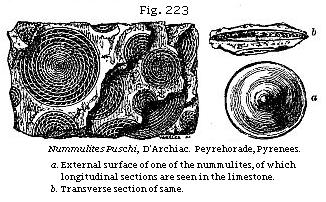
When we have once arrived at the conviction that the nummulitic formation occupies a middle and upper place in the Eocene series, we are struck with the comparatively modern date to which some of the greatest revolutions in the physical geography of Europe, Asia, and Northern Africa must be referred. All the mountain-chains, such as the Alps, Pyrenees, Carpathians, and Himalayas, into the composition of whose central and loftiest parts the nummulitic strata enter bodily, could have had no existence till after the Middle Eocene period. During that period the sea prevailed where these chains now rise, for nummulites and their accompanying testacea were unquestionably inhabitants of salt water. Before these events, comprising the conversion of a wide area from a sea to a continent, England had been peopled, as I before pointed out (p. 267), by various quadrupeds, by herbivorous pachyderms, by insectivorous bats, and by opossums.
Almost all the volcanoes which preserve any remains of their original form, or from the craters of which lava streams can be traced, are more modern than the Eocene fauna now under consideration; and besides these superficial monuments of the action of heat, Plutonic influences have worked vast changes in the texture of rocks within the same period. Some members of the nummulitic and overlying tertiary strata called flysch have actually been converted in the central Alps into crystalline rocks, and transformed into marble, quartz-rock, micha-schist, and gneiss.*
Eocene Strata in the United States.—In North America the Eocene formations occupy a large area bordering the
* Murchison, Quart. Journ. of Geol. Soc., vol. v, and Lyell, vol. vi, 1850. Anniversary Address.
Atlantic, which increases in breadth and importance as it is traced southward from Delaware and Maryland to Georgia and Alabama. They also occur in Louisiana and other States both east and west of the valley of the Mississippi. At Claiborne, in Alabama, no less than 400 species of marine shells, with many echinoderms and teeth of fish, characterise one member of this system. Among the shells, the Cardita planicosta, before mentioned (Fig. 191), is in abundance; and this fossil and some others identical with European species, or very nearly allied to them, make it highly probable that the Claiborne beds agree in age with the central or Bracklesham group of England, and with the calcaire grossiere of Paris.*
Higher in the series is a remarkable calcareous rock, formerly called “the nummulite limestone,” from the great number of discoid bodies resembling nummulites which it contains, fossils now referred by A. d’Orbigny to the genus Orbitoides, which has been demonstrated by Dr. Carpenter to belong to the foraminifera.† That naturalist, moreover, is of opinion that the Orbitoides alluded to (O. Mantelli) is of the same species as one found in Cutch, in the Middle Eocene or nummulitic formation of India.
Above the orbitoidal limestone is a white limestone, sometimes soft and argillaceous, but in parts very compact and calcareous. It contains several peculiar corals, and a large Nautilus allied to N. ziczac; also in its upper bed a gigantic cetacean, called Zeuglodon by Owen.‡
The colossal bones of this cetacean are so plentiful in the interior of Clarke County, Alabama, as to be characteristic of the formation. The vertebral column of one skeleton found by Dr. Buckley at a spot visited by me, extended to the length of nearly seventy feet, and not far off part of another backbone nearly fifty feet long was dug up. I obtained evidence, during a short excursion, of so many localities of this fossil animal within a distance of ten miles, as to lead me to conclude that they must have belonged to at least forty distinct individuals.
Professor Owen first pointed out that this huge animal was not reptilian, since each tooth was furnished with double roots (Fig. 224), implanted in corresponding double sockets; and his opinion of the cetacean nature of the fossil was afterwards
* See paper by the Author, Quart. Journ. of Geol.
Soc., vol. iv, p. 12; and Second Visit to the United States, vol.
ii, p. 59.
† Quart. Journ. of Geol. Soc., vol. vi, p. 32.
‡ See Memoir by R. W. Gibbes, Journ. of Acad. Nat. Sci.
Philad., vol. i, 1847.
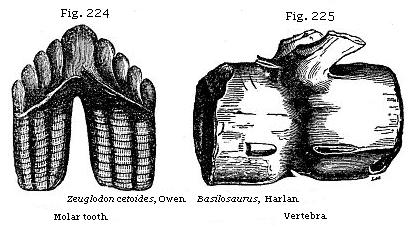
confirmed by Dr. Wyman and Dr. R. W. Gibbes. That it was an extinct mammal of the whale tribe has since been placed beyond all doubt by discovery of the entire skull of another fossil species of the same family, having the double occipital condyles only met with in mammals, and the convoluted tympanic bones which are characteristic of cetaceans.